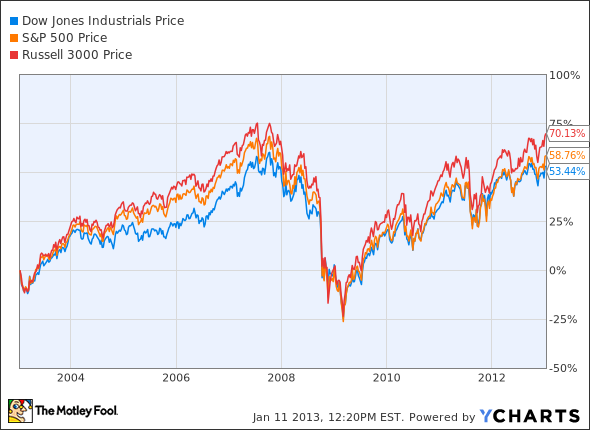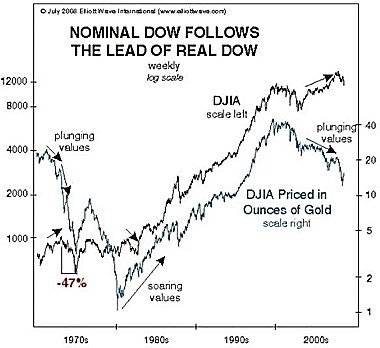Why The Dow Matters
Post on: 16 Март, 2015 No Comment

The Dow Jones Industrial Average (DJIA) is probably the most quoted financial barometer in the world and has become synonymous with the financial markets in general. When people say the market has gone up or down by a certain number of points, they’re usually referring to changes in the Dow. Read on to learn the history of the Dow and how to invest in it. (To learn about other stock indexes, see The ABCs of Stock Indexes .)
Brief History
Charles Dow, the creator of the DJIA, devised his first stock index in 1885. It consisted of two capitalized industrial and 12 capitalized railroad companies. Dow’s intent was to track U.S. economic strength by closely observing the companies considered to be the backbone of the U.S. economy. In 1886, he altered his index to contain 10 railroads and two industrials. In the mid-1890s, Dow recognized the growing importance of the industrial sector in the U.S. economy and again altered his index, this time to consist solely of industrial stocks. The first version of the DJIA, which contained 12 stocks, appeared in The Wall Street Journal on May 26, 1896. The following are the original 12 Dow stocks:
- American Cotton Oil
- American Sugar
- American Tobacco
- Chicago Gas
- Distilling & Cattle Feeding
- General Electric
- Laclede Gas
- National Lead
- North American
- Tennessee Coal and Iron
- U.S. Leather pfd.
- U.S. Rubber

While an odd looking combination by today’s economic standards, these 12 stocks were carefully chosen to represent the major areas of the U.S. economy at the time. The 30-stock Dow Jones Industrial Average debuted in 1929. Since then, it has changed over the years as some stocks were removed and others added to maintain an accurate reflection of the U.S. economy. Of the original 12 Dow stocks, General Electric (NYSE:GE ) is the only one that stood the test of time and was still in the index in 2008.
There are also two other Dow averages, the Dow Jones Utility Average (DJUA) and the Dow Jones Transportation Average (DJTA), which consists of stocks in the railroad, trucking, shipping and airline industries.
Today’s Dow
Considering the breadth of today’s economy, one might mistakenly believe that an index consisting of a mere 30 stocks could hardly be of any value. That is simply untrue. In addition to representing 30 of the most highly capitalized and influential companies in the U.S. economy, the Dow is also the financial media’s most referenced U.S. market index and remains a good indicator of general market trends.
If one compares a pricing chart of the Dow with a chart of the Wilshire 5000. the most inclusive of all U.S. indexes, it is evident that the two have followed astonishingly similar paths. The Dow has historically begun to decline for extended periods before the more speculative Nasdaq index, a pattern which occurred in the stock market downturns that began in April of 1998, January of 2000, December of 2001, January of 2004, December of 2004, and October of 2007. Some believe that when the stocks of the companies that makes up the DJIA begin to show weakness, the U.S. economy may be headed for a slowdown.
The other two Dow Jones indexes covering transportation and utilities can also signal market and economic trends. Those who subscribe to Dow theory analysis believe the three Dow Jones indexes can be used to confirm each other. The theory holds that if any of the three Dow Jones indexes, particularly the Dow 30 and the Transports, begin to diverge in direction during a market uptrend, caution may be warranted. The basic tenet of Dow theory is that the three Dow Jones indexes represent the major areas of the U.S. economy: industrials, transportation and utilities. When there is weakness in one,there may be weakness coming in the others and in the U.S economy in general. (For more insight, see Dow Theory .)
Ways to Invest in the DJIA
Two ETFs Proshares Trust Short Dow 30 (AMEX:DOG ) and Proshares Trust Ultra Short Dow 30 (AMEX:DXD ) seek to capitalize on the inevitable downward price moves of the Dow. Both move inversely to the Dow, with the latter ETF experiencing twice the price movement. If the Dow declines 1%, for example, DXD should advance by 2% and DOG should gain 1%. On the other hand, if the Dow advances, both ETFs would experience losses.
The options market offers another opportunity to capitalize on changes in the Dow. Options can be traded against the Dow Diamonds ETF. There are also options on the Dow (DJX). The DJX index option contract is based on 1/100 th of the current value of the DJIA. For example, when DJIA is at 11,000, the DJX level will be 110.
Further Education
To learn more about the Dow Jones Industrial Average and its component stocks visit the Dow Jones website. For more information on Dow Jones ETFs, a good resource is the ETF page on the American Stock Exchange (AMEX). The CBOE website has information on Dow 30 options.
Conclusion
The DJIA continues to serve its original purpose as a market and economic indicator, as set forth by Charles Dow back in 1929. As long as it contains the stocks of companies that reflect the major industrial areas of the U.S. economy during any given period, this 30-stock index will likely remain the gold standard of financial indicators.














